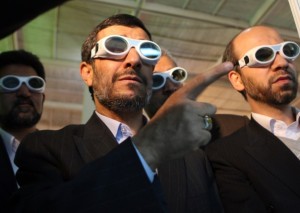Special to WorldTribune.com
LONDON — For the first time, the International Atomic Energy Agency (IAEA)
has determined that Iran is conducting a nuclear weapons program.
IAEA has issued a report that disclosed several Iranian nuclear weapons
programs over the last decade, including one meant to miniaturize a
Pakistani-designed warhead. The report, titled “Implementation of the NPT
Safeguards Agreement and relevant provisions of Security Council resolutions
in the Islamic Republic of Iran,” dismissed an assertion by the U.S.
intelligence community that Teheran suspended nuclear weapons efforts in
2003.

“Since 2002, the agency has become increasingly concerned about the possible existence in Iran of undisclosed nuclear related activities involving military related organizations, including activities related to the development of a nuclear payload for a missile, about which the agency has regularly received new information,” IAEA said in a report on Nov. 8.
The report, said to be based on information from 10 countries, said Iran worked to develop a nuclear weapon and tested components. The program included the procurement of dual-use and other equipment by the Iranian military and front companies.
“The agency has serious concerns regarding possible military dimensions to Iran’s nuclear programme,” the report, by far the most detailed issued by the agency, said. “After assessing carefully and critically the extensive information available to it, the agency finds the information to be, overall, credible.”
Iran was said to have acknowledged nuclear weapons activities. The
report said Teheran disclosed contacts with a secret nuclear supply network,
believed linked to Pakistani nuclear scientist Abdul Qadeer Khan, as early
as 1987, including an offer to develop uranium centrifuge enrichment
technology.
IAEA determined that Iran also tested high explosives and missile
warhead designs for nuclear weapons, one of which took place in 2003. The
report cited Iranian procurement of high speed electronic switches and spark
gaps, required to trigger and fire detonators.
“The development of safe, fast-acting detonators, and equipment suitable
for firing the detonators, is an integral part of a programme to develop an
implosion type nuclear device,” the report said. “Notwithstanding, given
their possible application in a nuclear explosive device, and the fact that
there are limited civilian and conventional military applications for such
technology, Iran’s development of such detonators and equipment is a matter
of concern, particularly in connection with the possible use of the
multipoint initiation system referred to below.”
One effort by Iran was to use the Shihab-3 ballistic missile as the
delivery vehicle for a nuclear weapon. The report said Iran, under a program
called Amad, designed a warhead for the reentry vehicle of Shihab, with a
range of at least 2,000 kilometers.
“It should be noted that the dimensions of the initiation system and the
explosives used with it were consistent with the dimensions for the new
payload which, according to the alleged studies documentation, were given to
the engineers who were studying how to integrate the new payload into the
chamber of the Shihab-3 missile re-entry vehicle,” the report said.
Iran was said to have established 10 nuclear facilities, half of them
still undeclared. The report cited the Fordow Fuel Enrichment Plant near
Qom, an underground facility exposed by Western intelligence in 2009.
“The information indicates that Iran has carried out activities relevant
to the development of a nuclear explosive device,” the report said. “The
information also indicates that prior to the end of 2003, these activities
took place under a structured programme, and that some activities may still
be ongoing.”
